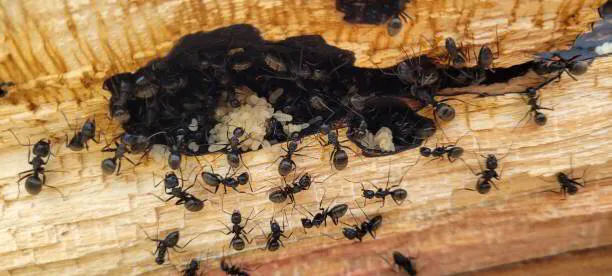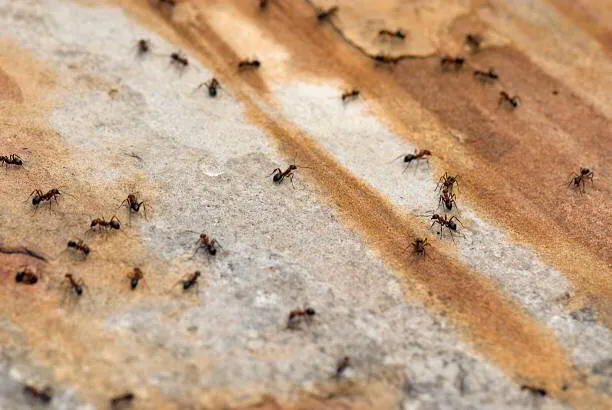What are Carpenter Ants?
Carpenter ants are large, destructive ants that invade our yards and homes in search of both food and shelter. They do vary in color, but most are black. Winged carpenter ants are often seen both inside and outside of a home. Reproductive carpenter ants swarm from their colony to find a mate and start a new colony. Ant swarms usually occur in the spring and are a sure sign that a carpenter ant nest is nearby.
Carpenter ants received their name because they create nests within wood. They prefer moist wood but also invade dry wood as well. Unlike termites, carpenter ants do not feed on the wooden structures they infest; they only tunnel through them to create nests and expand the colony.
Are Carpenter Ants dangerous?
The damage that carpenter ants can cause while nesting inside of a home’s structural wood is why they are dangerous pests. Also, like other species of ants, foraging carpenter ants spread bacteria onto the surfaces of your home and contaminate food sources. If you are spotting large, black ants wandering around inside or outside your house, it is best to contact a professional. Take fast action to limit the amount of damage these destructive ants can cause inside your home.
Why do I have a Carpenter Ant problem?
Carpenter ants create their main nest outside. However, if your home is located close to their outdoor nest it is very common for ants to find their way inside of it while foraging for food. Once inside if they often decide to stay and create a satellite nest for their colony that is close to their new-found food sources. They prefer to invade pieces of wood that have been damaged by water to nest within. Water-damaged wood is easier for them to excavate and create their tunnels and nesting galleries.
Where will I find Carpenter Ants?
If you are seeing large black ants wandering around your yard, garden areas, sidewalks, walkway, or deck, they have a nest nearby. Outside these ants place their nests in fallen trees, tree stumps, or landscaping timbers. If they have found their way inside of your to nest, they usually make their way to parts of your home where there is most likely to be a moisture problem – behind walls or under floors located in kitchens and bathrooms. Dishwashers, sinks, washers, and tubs are known for being leaky and causing moisture problems.
How do I get rid of Carpenter Ants?
Getting rid of carpenter ants from your yard, home, or business is best left up to a professional. The professionals at Amco Pest Solutions will provide you with the year-round solutions needed to get rid of carpenter ants and prevent their return. Whether you are looking to get rid of a current carpenter ant infestation or prevent future problems with ants our family-owned and operated company is here to help.
Our professionals are committed to providing the pest control services needed to help home and business owners keep their properties free of carpenter ants and other common pests. Amco Pest Solutions provides residential pest control and commercial pest control services throughout New Jersey, the Five Borough of New York, and South Florida. Reach out today to learn more about our effective ant control solutions.
Discover our control prevention services for more information.
How can I prevent Carpenter Ants in the future?
Eliminate Moisture Sources
Carpenter ants are attracted to moisture-damaged wood. Repair any leaks, fix plumbing issues promptly, and ensure proper ventilation to eliminate damp conditions. By reducing moisture, you make your home less appealing to carpenter ants.
Seal Entry Points
Thoroughly inspect and seal any cracks, gaps, or openings in the exterior of your home. Pay close attention to areas where utilities enter, as these can serve as entry points for carpenter ants. Use caulk, weather stripping, or other appropriate materials for sealing.
Trim Trees and Shrubs
Carpenter ants often use branches or vegetation as bridges to access structures. Trim trees, shrubs, and any overhanging branches that touch your home. This limits direct routes for carpenter ants and reduces the risk of infestations.
Store Firewood Away
Keep firewood and lumber stored away from your home and elevated above the ground. Carpenter ants can nest in firewood piles, and proximity to your home increases the chances of them finding their way indoors.
Regular Inspections
Strategically place traps along walls, corners, or areas of high mouse activity. Opt for humane traps or snap traps with bait to capture mice. Regularly check and reset traps for efficacy.
Professional Inspection
Schedule regular professional pest inspections to identify and address potential carpenter ant issues. Pest control professionals have the expertise to detect early signs of infestations, recommend tailored treatments, and apply insecticides strategically. Regular professional intervention can provide ongoing protection and peace of mind against carpenter ant problems.
Carpenter Ants Demystified: Quick Insights with Amco Pest Solutions
Join us for a rapid exploration into the world of carpenter ants! Discover the habits, risks, and effective solutions to keep these destructive ants away from your home. Get quick tips on identification and proactive measures. Watch now for essential insights into dealing with carpenter ants with Amco Pest Solutions!
Discover The World Of Carpenter Ants
Explore and learn about the ecology, diversity, and mystery of Carpenter Ants.
Utilizing advanced, eco-friendly techniques, our team effectively targets carpenter ants, preventing damage to structures while ensuring safety.
Understanding the nesting and feeding habits of carpenter ants is essential for identifying infestations and applying targeted control measures.
Prevention involves eliminating moisture sources, removing decaying wood, and sealing entry points to deter carpenter ants from entering.
What are Carpenter Ants?
Carpenter ants are large, destructive ants that invade our yards and homes in search of both food and shelter. They do vary in color, but most are black. Winged carpenter ants are often seen both inside and outside of a home. Reproductive carpenter ants swarm from their colony to find a mate and start a new colony. Ant swarms usually occur in the spring and are a sure sign that a carpenter ant nest is nearby.
Carpenter ants received their name because they create nests within wood. They prefer moist wood but also invade dry wood as well. Unlike termites, carpenter ants do not feed on the wooden structures they infest; they only tunnel through them to create nests and expand the colony.
Are Carpenter Ants dangerous?
The damage that carpenter ants can cause while nesting inside of a home’s structural wood is why they are dangerous pests. Also, like other species of ants, foraging carpenter ants spread bacteria onto the surfaces of your home and contaminate food sources. If you are spotting large, black ants wandering around inside or outside your house, it is best to contact a professional. Take fast action to limit the amount of damage these destructive ants can cause inside your home.
Why do I have a Carpenter Ant problem?
Carpenter ants create their main nest outside. However, if your home is located close to their outdoor nest it is very common for ants to find their way inside of it while foraging for food. Once inside if they often decide to stay and create a satellite nest for their colony that is close to their new-found food sources. They prefer to invade pieces of wood that have been damaged by water to nest within. Water-damaged wood is easier for them to excavate and create their tunnels and nesting galleries.
Where will I find Carpenter Ants?
If you are seeing large black ants wandering around your yard, garden areas, sidewalks, walkway, or deck, they have a nest nearby. Outside these ants place their nests in fallen trees, tree stumps, or landscaping timbers. If they have found their way inside of your to nest, they usually make their way to parts of your home where there is most likely to be a moisture problem – behind walls or under floors located in kitchens and bathrooms. Dishwashers, sinks, washers, and tubs are known for being leaky and causing moisture problems.
How do I get rid of Carpenter Ants?
Getting rid of carpenter ants from your yard, home, or business is best left up to a professional. The professionals at Amco Pest Solutions will provide you with the year-round solutions needed to get rid of carpenter ants and prevent their return. Whether you are looking to get rid of a current carpenter ant infestation or prevent future problems with ants our family-owned and operated company is here to help.
Our professionals are committed to providing the pest control services needed to help home and business owners keep their properties free of carpenter ants and other common pests. Amco Pest Solutions provides residential pest control and commercial pest control services throughout New Jersey, the Five Borough of New York, and South Florida. Reach out today to learn more about our effective ant control solutions.
Carpenter Ant Behavior and Adaptation
Carpenter ants are known for their ability to excavate wood to create nests, showcasing remarkable adaptation to various environments. Preferring moist or decaying wood, they indicate moisture issues in structures. Their nesting activities, while destructive to wooden structures, demonstrate their efficiency in establishing colonies, reflecting their adaptability and survival strategies in both natural and urban settings.
Lifecycle and Reproduction
The lifecycle of carpenter ants involves distinct stages: egg, larva, pupa, and adult. Queens lay eggs in moist wood, leading to colonies that can exist hidden within structures for years. This reproductive strategy enables them to establish extensive colonies, emphasizing the importance of early detection and management to prevent significant structural damage.
Carpenter Ants and Their Role in Ecosystems
Carpenter ants play a critical role in natural ecosystems by aiding in the decomposition of dead trees, contributing to nutrient cycling. However, in urban environments, their nesting habits can cause damage to wooden structures, underscoring the balance between their ecological benefits and the challenges they present when they intersect with human habitats.
Managing Carpenter Ant Populations
Managing carpenter ant populations involves identifying and eliminating moisture sources, sealing entry points to prevent access, and removing decaying wood near homes. Professional pest control may be necessary for severe infestations, employing strategies that target the queen and colony directly. Early intervention and preventive measures are key to controlling their impact on structures.
How can I prevent Carpenter Ants in the future?
Eliminate Moisture Sources
Carpenter ants are attracted to moisture-damaged wood. Repair any leaks, fix plumbing issues promptly, and ensure proper ventilation to eliminate damp conditions. By reducing moisture, you make your home less appealing to carpenter ants.
Seal Entry Points
Thoroughly inspect and seal any cracks, gaps, or openings in the exterior of your home. Pay close attention to areas where utilities enter, as these can serve as entry points for carpenter ants. Use caulk, weather stripping, or other appropriate materials for sealing.
Trim Trees and Shrubs
Carpenter ants often use branches or vegetation as bridges to access structures. Trim trees, shrubs, and any overhanging branches that touch your home. This limits direct routes for carpenter ants and reduces the risk of infestations.
Store Firewood Away
Keep firewood and lumber stored away from your home and elevated above the ground. Carpenter ants can nest in firewood piles, and proximity to your home increases the chances of them finding their way indoors.
Regular Inspections
Strategically place traps along walls, corners, or areas of high mouse activity. Opt for humane traps or snap traps with bait to capture mice. Regularly check and reset traps for efficacy.
Professional Inspection
Schedule regular professional pest inspections to identify and address potential carpenter ant issues. Pest control professionals have the expertise to detect early signs of infestations, recommend tailored treatments, and apply insecticides strategically. Regular professional intervention can provide ongoing protection and peace of mind against carpenter ant problems.
Discover More Pests & Rodents Below!
Carpenter Ants Demystified: Quick Insights with Amco Pest Solutions
Join us for a rapid exploration into the world of carpenter ants! Discover the habits, risks, and effective solutions to keep these destructive ants away from your home. Get quick tips on identification and proactive measures. Watch now for essential insights into dealing with carpenter ants with Amco Pest Solutions!



